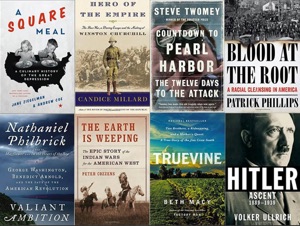The best history books of 2016 and personal professional development

During the glory days of the Teaching American History projects, we handed out books like candy. We’d read. Argue. Reflect. Move on to the next. And I’m sure there were some who didn’t enjoy that process as much as I did. I understand that we all learn in different ways but it’s just hard for me to imagine life without books to read and talk about.
Plain and simple truth? You can never have enough books.
Keith Houston in his recent book titled, wait for it . . . The Book: A Cover-to-Cover Exploration of the Most Powerful Object of Our Time, advises readers to
Find the biggest, grandest hardback you can. Hold it in your hands. Open it and hear the rustle of paper and the crackle of glue. Smell it! Flip through the pages and feel the breeze on your face.
Preach it.
Houston continues and explains what his book is about:
. . . the unrepentantly analog contraptions of paper, ink, cardboard, and glue that we have lived with and depended on for so long. It is about books that have mass and odor, that fall into your hands when you ease them out of a bookcase and that make a thump when you put them down. It is all too easy to take the existence of physical books for granted. The sheer weight of them that surrounds us at all times . . . leads to a kind of bibliographic snow blindness.
Not today, Keith. Not today.
Today you get a set of lists highlighting some of the best history books of 2016. Take some time. Browse through the collection and pick one. Or two. Three? Maybe, just maybe, create a schedule of of books that you commit to reading. Then, stick to the schedule. Make it the one New Year’s resolution that you keep.
Cause it’s not just about the books. It’s about the personal professional learning that happens when you crunch all of that new knowledge back into your lesson design.
(Need some PDC or college credit? I can do that. Get ahold of me and ESSDACK will work out some independent study designed just for you.)
- Top History Books of 2016 – Smithsonian
- Notable Non-fiction of 2016 – New York Times
- Great History Books of 2016 – Bloomberg
- Amazon Best Sellers – History
- 10 Best History Books – The Independent
- Best Books of 2016: History – Financial Times
- The Best History Books of 2016 – History Today
- The Best History Books – The Guardian
- Best History & Biography – Good Reads
My list for 2017?
There was a time when young people were the most passionate participants in American democracy. In the second half of the nineteenth century, young people led the way, hollering, fighting, and flirting at massive midnight rallies. Parents trained their children to be “violent little partisans,” while politicians lobbied twenty-one-year-olds for their “virgin votes”—the first ballot cast upon reaching adulthood.
Drawing on hundreds of diaries and letters of diverse young Americans, this book explores how exuberant young people and scheming party bosses relied on each other from the 1840s to the turn of the twentieth century. It also explains why this era ended so dramatically and asks if aspects of that strange period might be useful today.
“A fascinating look at the twelve days leading up to the Japanese attack on Pearl Harbor—the warnings, clues and missteps—by a Pulitzer Prize–winning reporter. The author’s telescoping of the twelve days leading to the attack unravels the crucial characters and moments, and produces an edge-of-your seat drama with fascinating details about America at this moment in its history. By the end, the reader understands how assumption is the root of disaster, and how sometimes a gamble pays off.”
The Long Weekend: Life in the English Country House, 1918-1939
“In The Long Weekend, historian Adrian Tinniswood introduces us to the tumultuous, scandalous and glamourous history of English country houses during the years between World Wars. Drawing on thousands of memoirs, letters, and diaries, as well as the eye-witness testimonies of belted earls and bibulous butlers, Tinniswood brings the stately homes of England to life as never before, opening the door to a world by turns opulent and ordinary, noble and vicious, and forever wrapped in myth.”
A Square Meal: A Culinary History of the Great Depression
“The decade-long Great Depression, a period of shifts in the country’s political and social landscape, forever changed the way America eats. Before 1929, America’s relationship with food was defined by abundance. But the collapse of the economy, in both urban and rural America, left a quarter of all Americans out of work and undernourished—shattering long-held assumptions about the limitlessness of the national larder.”
















These all look like great fun! It’s been a long time since I last read a history book that focused on food, so maybe I’ll check out the last on your list. Thanks for the suggestions.
Lists like these always get me in trouble! There’s just too many fun things I want to read. Enjoy A Square Meal!
glennw